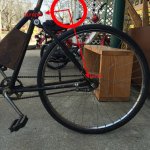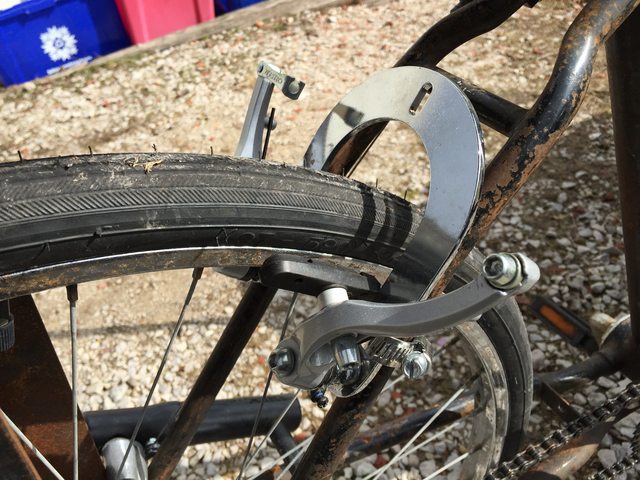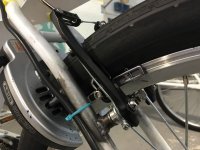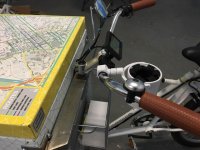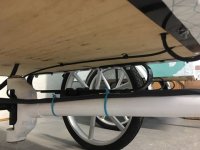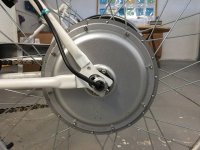eobanb
10 µW
Hi all,
This is my first post here so I apologise in advance if I run afoul of any conventions. To get right to the point, about a month ago I acquired an old Worksman model STPT, which is a front-load cargo tricycle. It was previously used in a Ford transmission plant in Indianapolis that recently closed; I got it quite cheap from a nearby bike co-op.
Anyway, some of it was pretty damaged—I've replaced the front axle and some of the bearings, which at least got it rideable. The rear single-speed coaster brake wheel was badly bent, and so yesterday I replaced it with a new (old) Schwinn S-6 wheel with a Shimano 3SC hub (three-speed hub with coaster brake). For some visual context, here is the complete trike from a few days ago, before I replaced the single-speed wheel:

Here is the new three-speed wheel:

The trike rides well on flat ground, but unfortunately it is quite difficult to pedal uphill even in low gear. I would guess it weighs about 100 lbs unladen, and the steering dynamics don't really allow the rider to stand up on the pedals. Right now I live in a pretty flat neighbourhood, but in August I am moving a few blocks away up a hill. This seems like a perfect opportunity for a modest electric conversion. I am not looking for speed here, I am looking for torque. The sole point of this conversion is to be able to go uphill, not to keep up with motor traffic. Going more than about 12 mph on this thing would be suicide anyway. So begins my search for a decent but cheap electric setup.
Some things to know: there are no braze-ons for racks, fenders, or anything else; in fact it's not even drilled for a rim brake. Fortunately there is plenty of clearance for just about any sort of 26" wheel—I already had to bend it out a bit to fit the three-speed hub. I figure that because of the design of the trike, an electric conversion will almost certainly have to be a rear wheel hub, and the battery pack and controller will be stored in the front box (the front box is rated to hold 500 lbs, so this will be no problem). I think I'd prefer a pre-built wheel over a bare motor.
Apart from these constraints, I am open to just about any recommendations people have with regard to amperages, voltages, motors, controllers, and batteries. I assume something mid-range, (like a 36V / 500W system) would work fine? I once owned a cheap 24-volt Currie eZip electric bike about six years ago, but apart from that, my experience with electric bikes is limited.
Thanks!
This is my first post here so I apologise in advance if I run afoul of any conventions. To get right to the point, about a month ago I acquired an old Worksman model STPT, which is a front-load cargo tricycle. It was previously used in a Ford transmission plant in Indianapolis that recently closed; I got it quite cheap from a nearby bike co-op.
Anyway, some of it was pretty damaged—I've replaced the front axle and some of the bearings, which at least got it rideable. The rear single-speed coaster brake wheel was badly bent, and so yesterday I replaced it with a new (old) Schwinn S-6 wheel with a Shimano 3SC hub (three-speed hub with coaster brake). For some visual context, here is the complete trike from a few days ago, before I replaced the single-speed wheel:

Here is the new three-speed wheel:

The trike rides well on flat ground, but unfortunately it is quite difficult to pedal uphill even in low gear. I would guess it weighs about 100 lbs unladen, and the steering dynamics don't really allow the rider to stand up on the pedals. Right now I live in a pretty flat neighbourhood, but in August I am moving a few blocks away up a hill. This seems like a perfect opportunity for a modest electric conversion. I am not looking for speed here, I am looking for torque. The sole point of this conversion is to be able to go uphill, not to keep up with motor traffic. Going more than about 12 mph on this thing would be suicide anyway. So begins my search for a decent but cheap electric setup.
Some things to know: there are no braze-ons for racks, fenders, or anything else; in fact it's not even drilled for a rim brake. Fortunately there is plenty of clearance for just about any sort of 26" wheel—I already had to bend it out a bit to fit the three-speed hub. I figure that because of the design of the trike, an electric conversion will almost certainly have to be a rear wheel hub, and the battery pack and controller will be stored in the front box (the front box is rated to hold 500 lbs, so this will be no problem). I think I'd prefer a pre-built wheel over a bare motor.
Apart from these constraints, I am open to just about any recommendations people have with regard to amperages, voltages, motors, controllers, and batteries. I assume something mid-range, (like a 36V / 500W system) would work fine? I once owned a cheap 24-volt Currie eZip electric bike about six years ago, but apart from that, my experience with electric bikes is limited.
Thanks!


